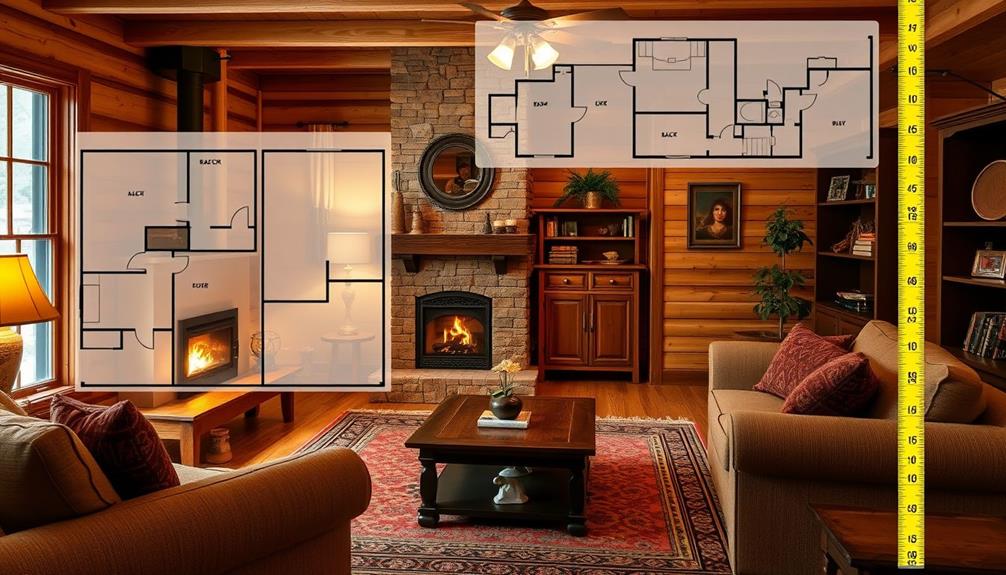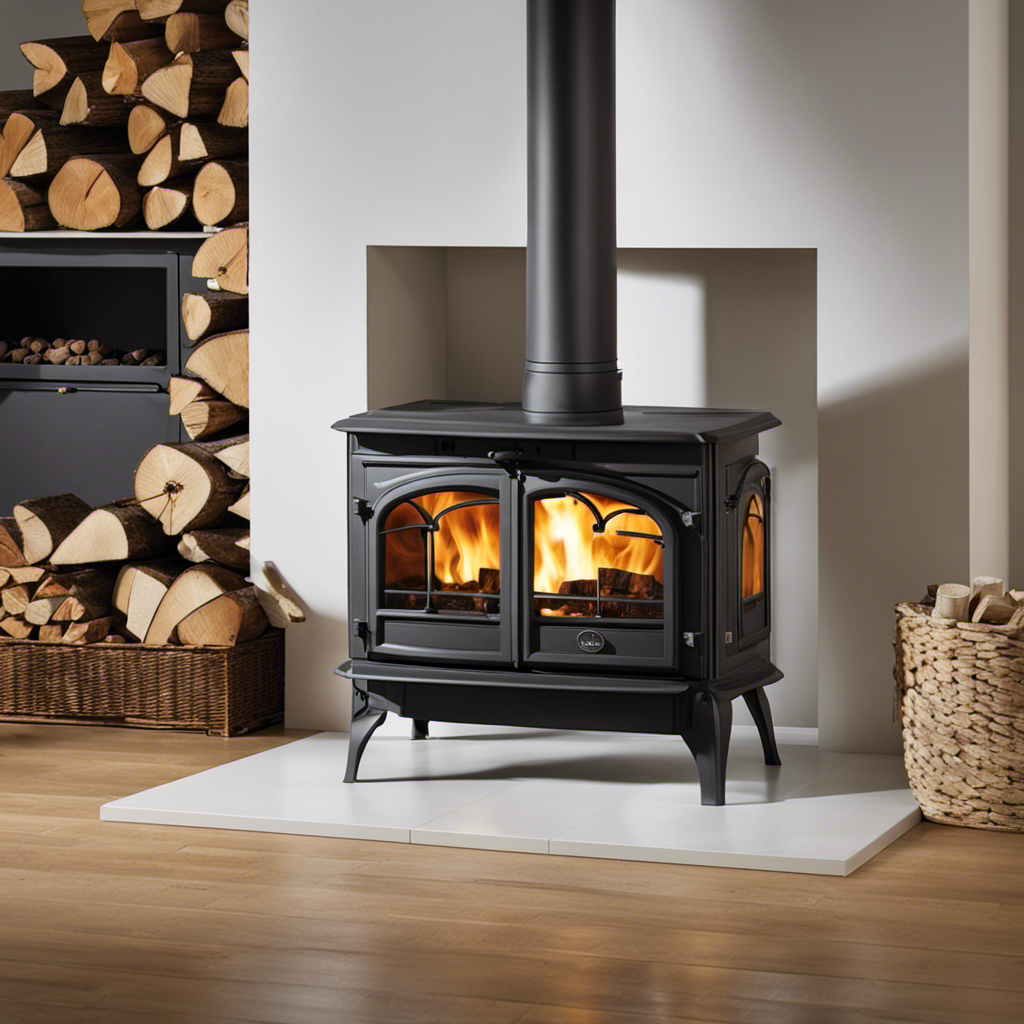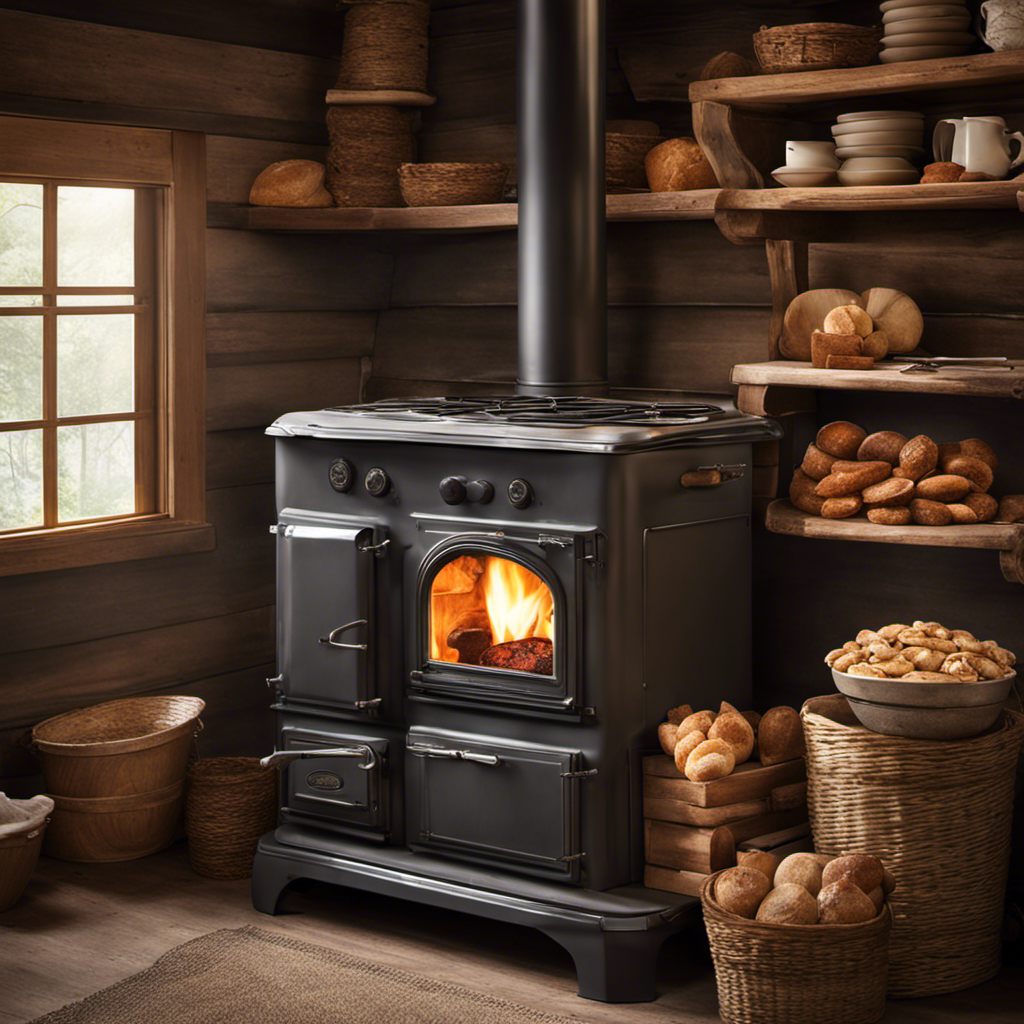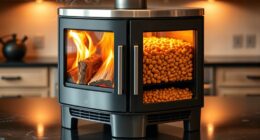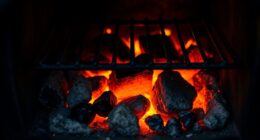Choosing the right size wood stove for your space is essential for comfort and efficiency. Start by calculating your room's cubic volume, then consider insulation quality, ceiling height, and layout. Small stoves typically heat up to 500 sq. ft., while large models cover up to 2,200 sq. ft. A good rule is to estimate around 20 BTUs per square foot. If your insulation is poor, you'll need a larger stove. Always opt for a model that suits your specific heating needs. For a deeper understanding of these factors, you can explore what options best fit your requirements.
Key Takeaways
- Calculate the room's cubic volume by multiplying its length, width, and height to determine heating needs accurately.
- Assess insulation quality, as good insulation allows for smaller stoves, while poor insulation requires larger models for effective heating.
- Consider ceiling height; taller ceilings increase room volume, necessitating more BTUs and potentially larger wood stoves.
- Use a wood stove size calculator to estimate the required kilowatt output based on room dimensions and insulation factors.
- Evaluate the layout and window sizes, as open spaces and well-insulated windows can reduce the stove size needed for adequate heating.
Understanding Wood Stove Benefits
When you choose the right size wood stove, you not only enhance your home's comfort but also enjoy significant energy savings. A properly sized wood stove provides efficient heating tailored to your specific heating needs.
For instance, small stoves can heat up to 500 sq. ft., while medium stoves cover 500-1,000 sq. ft., and large models accommodate 1,000-2,200 sq. ft. The BTU rating of different stoves guarantees you're using the appropriate BTUs, generally estimated at 20 BTUs per square foot.
Factors such as insulation quality, ceiling height, and room layout influence the heating capacity required from your wood stove. Selecting a model that aligns with these variables helps prevent issues like creosote buildup and overheating, creating a safer living environment.
To assist in this process, a wood stove size calculator can be immensely helpful. This tool allows you to input your room dimensions and insulation levels, guaranteeing you choose a stove that meets your specific requirements.
Determining Proper Size
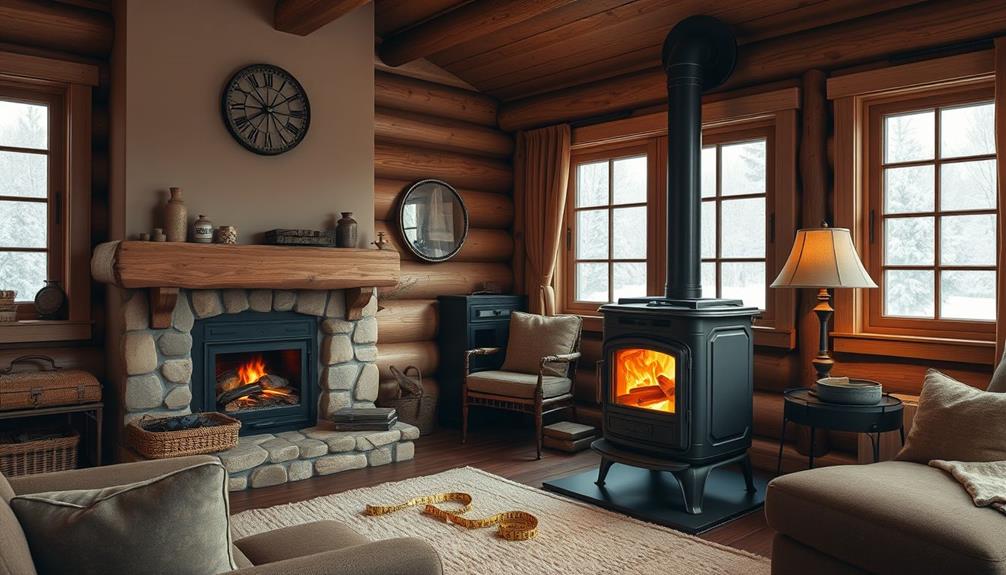
Choosing the right size wood stove involves careful calculations to guarantee ideal heating for your space. Start by determining the room's cubic volume by multiplying its length, width, and height.
Then, divide that figure by 14 for average insulation, 10 for poor insulation, and 25 for super-insulated rooms to find the required kilowatt output. This process helps you understand the heating capacity you'll need.
For instance, a stove like the Englander 10-Cpm, which generates up to 50,000 BTUs, is suitable for heating areas up to 2,200 square feet, making it a great option for larger spaces high-efficiency ratings.
Next, consider the square footage of the area you want to heat. A small wood stove typically covers up to 500 sq ft, while medium stoves heat 500 to 1,000 sq ft.
Large stoves cater to 1,000 to 2,200 sq ft, and extra-large units are for spaces over 2,200 sq ft. Don't forget that ceiling height impacts your BTU needs; higher ceilings require more BTUs.
Calculating Heating Needs
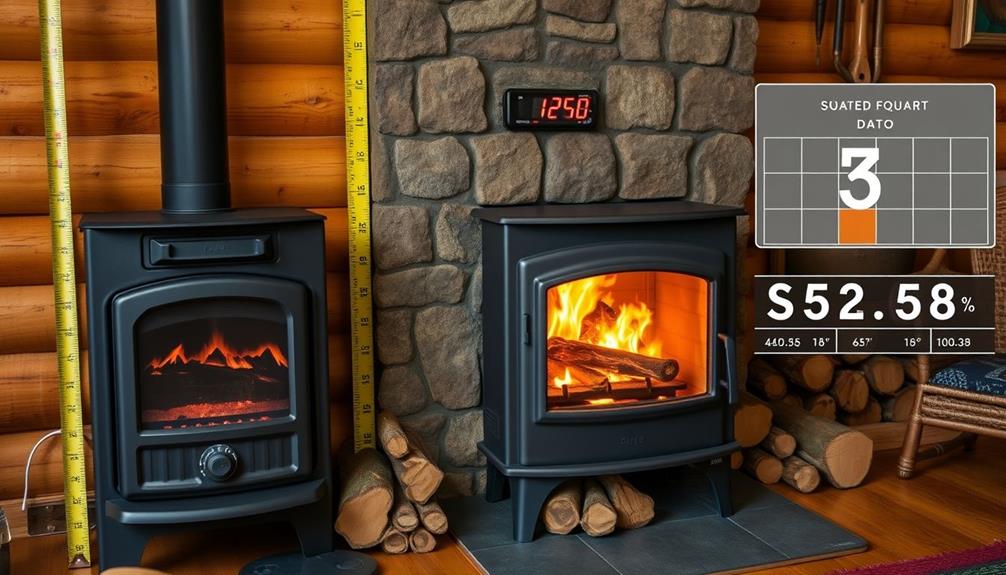
Calculating your heating needs is crucial for selecting the right wood stove for your space. Start by measuring the cubic dimensions of your room by multiplying the width, length, and height. This gives you a total volume to work with.
You'll then divide this volume by specific factors based on your insulation quality. For ideal efficiency, consider how other heating systems, like heat pump technology, can complement your heating strategy.
- Average insulation: Divide by 14
- Poor insulation: Divide by 10
- Super-insulated: Divide by 25
After you find the required kilowatt output, you'll know the size wood burning stove you need. For reference, a small wood stove typically requires 4-6 kW, a medium stove needs 7-9 kW, and a large stove calls for 10-15 kW. If you need above 15 kW, you're looking at an extra-large stove.
Also, keep in mind that ceiling height and window size can greatly impact your heating capacity and heating costs. A higher ceiling means more BTUs are necessary to maintain warmth.
Factors Affecting Heating Capacity
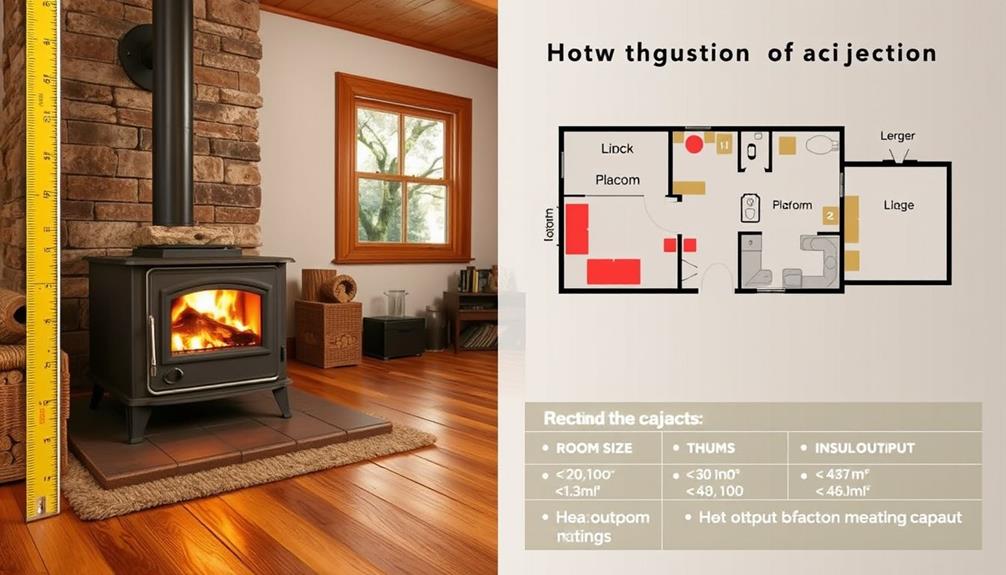
When choosing a wood stove, several factors affect its heating capacity.
You'll want to take into account your room's ceiling height, insulation quality, and how many windows you have, as these elements can greatly influence heat retention and distribution.
For example, adequate insulation can reduce heating needs, while high ceilings may require a more powerful stove.
Additionally, understanding toilet maintenance practices can help you learn how to ascertain other systems in your home are functioning at their best, enhancing overall comfort.
The layout of your space will play a key role in determining how effectively the stove warms your home.
Ceiling Height Impact
Ceiling height plays an essential role in determining your wood stove's heating capacity. The taller your ceilings, the more BTUs you'll need to heat your space effectively. For every extra foot above the standard 8 feet, you may need to increase your stove's capacity by about 10-15%.
Understanding your room's cubic dimensions (length x width x height) helps you calculate your heating needs accurately. Additionally, consider how the size of your space can influence other home features, such as your garage door openers, which may also enhance your overall home efficiency.
Consider these factors:
- Higher ceilings increase the volume of the room, requiring more BTUs.
- Rooms with vaulted ceilings may need specialized heating strategies, as heat rises.
- Poor insulation can greatly hinder heat efficiency, demanding a larger stove.
- Adjustments to heating capacity should be made based on insulation quality.
Insulation Quality Considerations
Since insulation quality directly impacts your wood stove's efficiency, understanding its significance is essential for effective heating. If your space is poorly insulated, you'll find that heat escapes more readily, requiring a larger wood stove to maintain comfortable temperatures.
Good insulation typically allows for about 1 kW of heating capacity for every 14 cubic meters, while poorly insulated areas may need up to 1 kW for every 10 cubic meters. Proper insulation is vital, much like ensuring your dogs have a healthy weight to prevent obesity-related problems dog health tips.
Older homes often suffer from lower insulation quality, which can compromise your wood stove's heating capacity and lead to higher fuel consumption. Furthermore, the window size and the number of windows can introduce drafts, allowing cool air to seep in and further affect heating efficiency.
If you're in a super-insulated room, you might only need 1 kW for every 25 cubic meters, indicating that a smaller wood stove could suffice.
Conducting an insulation assessment is vital. By understanding your insulation quality, you can determine the appropriate wood stove size, ensuring you're equipped to heat your space efficiently without overcompensating for heat loss.
Window and Layout Effects
The layout of your space and the number of windows can greatly influence the heating capacity of your wood stove.
When you evaluate your environment, consider how these factors impact your heating needs:
– Number and size of windows: Larger or older windows may allow more cold air in, increasing heat loss and requiring a larger stove.
Additionally, homes with multiple windows may benefit from diversification of retirement portfolio strategies to manage financial risks effectively.
- Room layout: Open layouts promote better airflow and heat distribution, potentially reducing the necessary stove size.
- Ceiling height: High ceilings mean more air volume to heat, which can necessitate a larger stove for adequate BTUs.
- Insulation quality: Well-insulated windows (like double glazing) minimize heat loss, allowing for smaller stoves to be effective.
Exploring Wood Stove Technologies
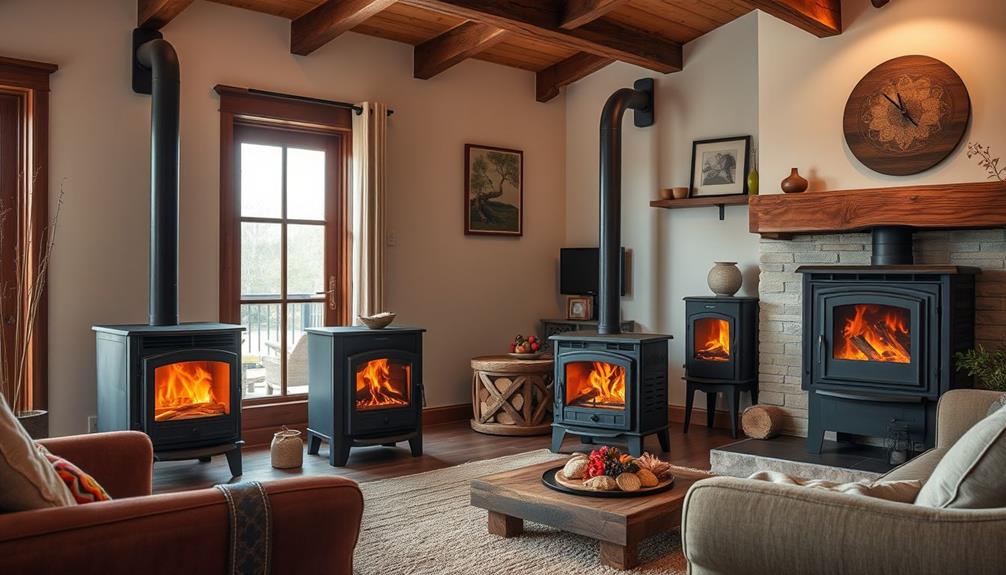
When it comes to choosing a wood stove, understanding the different technologies available can considerably impact your heating experience.
You'll primarily encounter two types: Non-Catalytic and Hybrid Catalytic. Non-Catalytic models are ideal for intermittent heating needs and use a simpler combustion process. They're easier to maintain but generally offer lower efficiency ratings compared to their counterparts.
Additionally, AI technology revolutionizes traditional heating solutions by optimizing energy use and enhancing overall comfort in your space.
On the other hand, Hybrid Catalytic stoves are designed for continuous heating applications. They incorporate a catalytic combustor, enhancing heat output while minimizing smoke emissions. This technology allows Hybrid Catalytic stoves to often exceed 80% efficiency, making them a smart choice for those who prioritize fuel efficiency and cleaner burning.
Both technologies are EPA-certified, ensuring they meet strict emissions and efficiency standards.
Your choice should depend on your specific heating requirements and personal preferences. If you want a hassle-free option with less maintenance, a Non-Catalytic stove might suit you. However, if you're looking for greater efficiency and consistent heating, a Hybrid Catalytic model could be the way to go.
Understanding these differences can help you make an informed decision for your space.
Popular Wood Stove Models
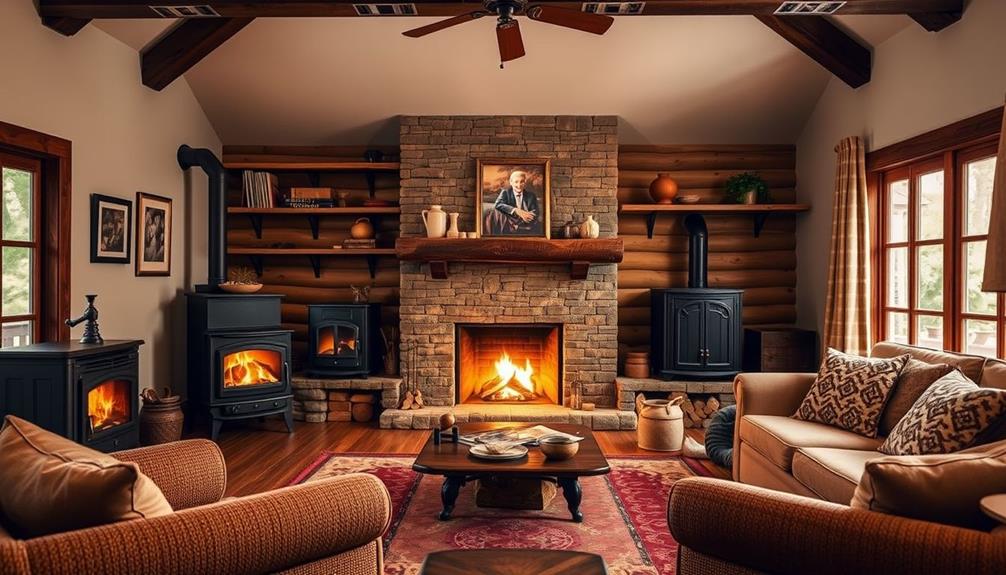
Choosing a wood stove can be exciting, especially with the variety of popular models available today. When selecting a model, consider your heating needs and the space you want to warm.
Two standout series are the Quadra-Fire Discovery and Millennium Series, each offering unique features. Additionally, modern wood stoves can enhance energy efficiency and contribute to lower heating costs, similar to how ceiling fans promote energy savings.
- Discovery Series: Ideal for cabins, these models cater to spaces ranging from 1,000 to 3,000 square feet.
- Millennium Series: Includes models like the 2100, 3100, and 4300, designed for both small and large areas with traditional aesthetics.
- Efficiency: Both series utilize advanced technologies like the Four-Point Burn System and Automatic Combustion Control, enhancing efficiency while minimizing emissions.
- Convenience: Many Quadra-Fire stoves come with built-in firewood storage beneath the firebox, making it easier to keep your fuel close at hand.
Popular models such as the Quadra-Fire Discovery I and II are engineered for ideal performance and comply with EPA emissions regulations.
With these options, you can find a wood stove that not only meets your heating needs but also aligns with modern efficiency and environmental standards.
Maintenance and Safety Considerations
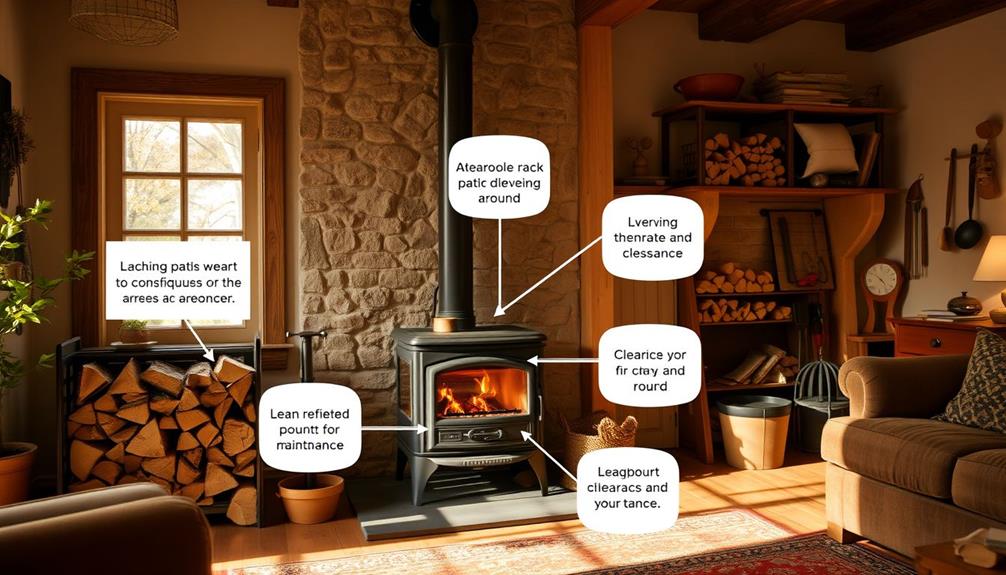
After selecting the right wood stove for your home, keeping it in top condition is key to guaranteeing safety and efficiency. Regular maintenance is essential; clean the firebox and chimney flue at least once a year to prevent dangerous creosote buildup, which can cause chimney fires.
Make sure your stove is installed according to local building codes, including proper chimney height and clearances from combustible materials. Additionally, using a high-quality air purifier can help maintain indoor air quality by reducing pollutants that may arise from wood burning, especially if you have concerns about air quality management.
To optimize efficiency and minimize emissions, always use well-seasoned, dry wood. Burning unseasoned wood can increase creosote accumulation and reduce heat output.
Additionally, installing a carbon monoxide detector in the heated space is critical, as this odorless gas can pose serious health risks if ventilation is inadequate.
Conduct periodic inspections for any signs of wear or damage, like cracks in the stove body or flue. Addressing these issues promptly helps maintain safety and guarantees your wood stove operates at peak performance throughout the heating season.
Frequently Asked Questions
Can a Wood Stove Be Too Big for a Room?
Yes, a wood stove can definitely be too big for a room. An oversized stove can lead to overheating, excessive wood use, and safety hazards, making it essential to choose the right size for efficiency.
What Size Wood Stove to Heat 1500 Sq Ft?
Imagine you're in a cozy cabin during winter. To effectively heat 1,500 sq ft, you'll need a wood stove providing around 30,000 BTUs. Consider insulation and ceiling height for ideal warmth and efficiency.
How Much Space Do I Need Around a Wood Burning Stove?
You need to maintain at least 36 inches of clearance around your wood-burning stove from combustible materials. Confirm your hearth extends 18 inches in front and 8 inches on each side for safety and protection.
How Big of a Room Can a Wood Stove Heat?
Imagine you've got a medium wood stove in your cabin. It'll comfortably heat up to 1,000 square feet. Remember, insulation and layout can affect how well it warms your specific space, too.
Conclusion
Choosing the right size wood stove for your space can make all the difference in comfort and efficiency. By understanding your heating needs and considering factors like insulation and room size, you're sure to find the perfect fit. Remember, it's better to be safe than sorry—always prioritize maintenance and safety to keep your stove running smoothly. So, don't let the cold get you down; invest wisely, and enjoy those cozy nights by the fire!

